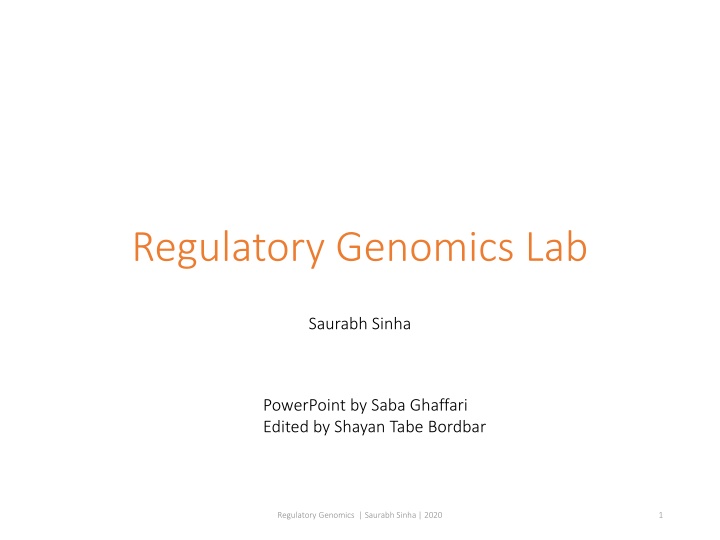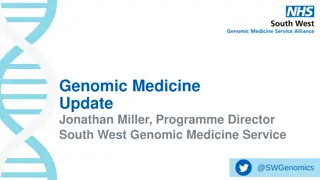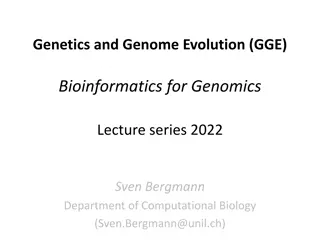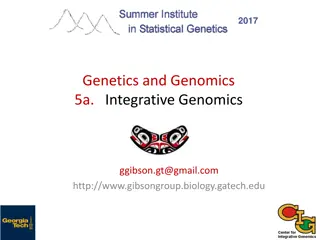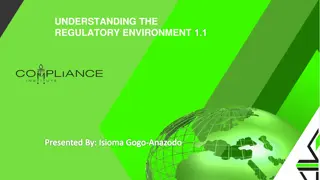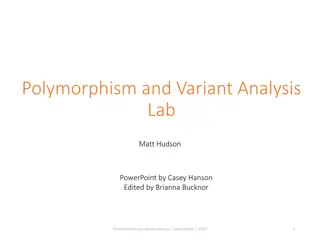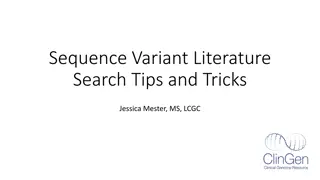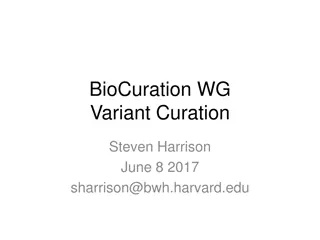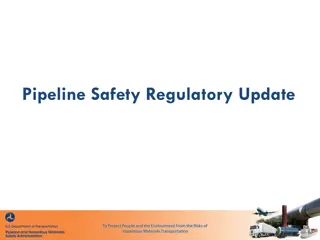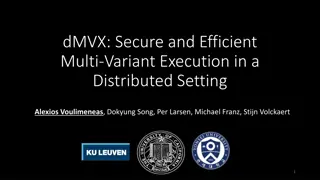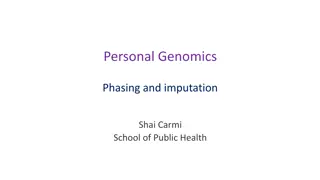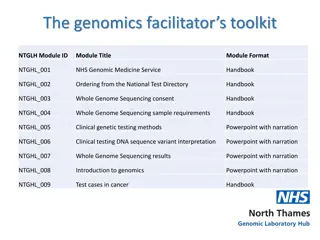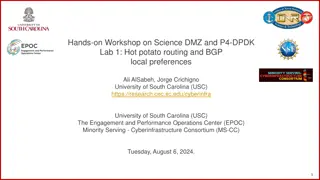Regulatory Genomics Lab and Variant Calling Workshop Overview
This content provides an overview of the Regulatory Genomics Lab and Variant Calling Workshop by Saurabh Sinha, including a step-by-step guide on utilizing command line tools for ChIP track manipulation, MEME suite analysis, gene set enrichment testing, and more. Instructions for starting the VM, accessing the IGB Biocluster, and lab setup details are also included. Explore the content for a comprehensive understanding of the practical applications in regulatory genomics and variant calling.
Download Presentation

Please find below an Image/Link to download the presentation.
The content on the website is provided AS IS for your information and personal use only. It may not be sold, licensed, or shared on other websites without obtaining consent from the author.If you encounter any issues during the download, it is possible that the publisher has removed the file from their server.
You are allowed to download the files provided on this website for personal or commercial use, subject to the condition that they are used lawfully. All files are the property of their respective owners.
The content on the website is provided AS IS for your information and personal use only. It may not be sold, licensed, or shared on other websites without obtaining consent from the author.
E N D
Presentation Transcript
Regulatory Genomics Lab Saurabh Sinha PowerPoint by Saba Ghaffari Edited by Shayan Tabe Bordbar Regulatory Genomics | Saurabh Sinha | 2020 1
In this lab, we will do the following: In this lab, we will do the following:. Use command line tools to manipulate a ChIP track for BIN TF in D. Mel. Subject peak sets to MEME suite. Compare MEME motifs with Fly Factor Survey motifs for BIN TF. Subject peak set to a gene set enrichment test. Regulatory Genomics | Saurabh Sinha | 2020 2
1 2 3 Selected ChIP peaks (100 strong binding sites of the TF) TF Motif inferred from selected ChIP peaks MEME CHIP-seq peaks (Binding sites of a TF) DNA sequences of selected ChIP peaks 5 Gene Ontology terms enriched in genes near ChIP peaks DAVID Genes near ChIP peaks Genes near ChIP peaks (converted IDs) 7 6
Step 0A: Start the VM Follow instructions for starting VM. (This is the Remote Desktop software.) The instructions are different for UIUC and Mayo participants. Instructions for UIUC users are here: http://publish.illinois.edu/compgenomicscourse/files/2020/06/SetupV M_UIUC.pdf Instructions for Mayo users are here: http://publish.illinois.edu/compgenomicscourse/files/2020/06/VM_Set up_Mayo.pdf Variant Calling Workshop | Chris Fields | 2020 4
Step 0B: Accessing the IGB Biocluster Open Putty.exe Putty.exe In the hostname hostname textbox type: biologin.igb.illinois.edu Click Open Open If popup appears, Click Yes Yes Enter login credentials assigned to you; example, user class00 class00. Now you are all set! Now you are all set! 5
In PuTTY In PuTTY Step 0C: Lab Setup The lab is located in the following directory: /home/classroom/mayo/2020/06_Regulatory_Genomics/ Following commands will copy a shell script -designed to prepare the working directory- to your home directory. Follow these steps to copy and then submit the script as a job to biocluster: $ cd ~/ # Note ~ is a symbol in Unix paths referring to your home directory $ cp /home/classroom/mayo/2020/06_Regulatory_Genomics/src/prep-directory.sh ./ # Copies prep-directory.sh script to your working directory. $ sbatch prep-directory.sh # submits a job to biocluster to populate your home directory with necessary files $ squeue u <userID> # to check the status of the submitted job 6
Step 0D: Working directory: data Navigate to the created directory for this exercise and look what data folder contains. $ cd 06_Regulatory_Genomics Name Description $ ls ChIP peaks for BIN transcription factor in GFF format # output should be: BIN_Fchip_s11_1000.gff # data results src $ ls data/ Drosophila Melanogaster genome # BIN_Fchip_s11_1000.gff dm3.fasta # dm3.fasta # flygenes_vm.bed Coordinates of all Drosophila genes in BED format flygenes_vm.bed 7
Step 0E: Working directory: scripts Navigate to the directory containing the scripts and look what s inside. $ cd src $ ls *.sh # lists the scripts to be used in this lab: # get_closest_genes.sh get_sequence.sh get_top100.sh 8
Computational Prediction of Motifs In this exercise, after performing various file manipulations, we will use the MEME suite to identify a motif from the top 100 ChIP regions. Subsequently, we will compare our predicted motif with the experimentally validated motif for BIN at Fly Factor Survey. Regulatory Genomics | Saurabh Sinha | 2020 9
1 2 3 Selected ChIP peaks (100 strong binding sites of the TF) TF Motif inferred from selected ChIP peaks MEME CHIP-seq peaks (Binding sites of a TF) DNA sequences of selected ChIP peaks 5 Gene Ontology terms enriched in genes near ChIP peaks DAVID Genes near ChIP peaks Genes near ChIP peaks (converted IDs) 7 6
Step 1: Obtain the top 100 strongest ChIP peaks We will use sort command, to sort the peaks based on their score and then take the top 100 peaks. Use the following line to get get the top 100 chip peaks from the original ChIP gff file. $ cd ~/06_Regulatory_Genomics/src/ $ head ~/06_Regulatory_Genomics/data/BIN_Fchip_s11_1000.gff $ sbatch get_top100.sh # OUTPUT in ~/06_Regulatory_Genomics/results/Top_100_peaks.gff Regulatory Genomics | Saurabh Sinha | 2020 11
Please do not try to Run the commands in this slide. This is just to explain what the script that we just ran (get_top100.sh) is supposed to do in more detail. What s inside the get_top100.sh script? #!/bin/bash #SBATCH -c 1 #SBATCH --mem 8000 #SBATCH -A Mayo_Workshop #SBATCH -J getTop100 #SBATCH -o getTop100.%j.out #SBATCH -e getTop100.%j.err #SBATCH -p classroom Tells the cluster job manager what resources you want (1 CPU, 8GB memory), run on the classroom nodes, and name the job getTop100 # this is our input (gff) export TOBESORTED=../data/BIN_Fchip_s11_1000.gff Create shortcut name for input ChIP peak file in GFF format. sort -k 6,6nr $TOBESORTED | head -100 > ../results/Top_100_peaks.gff Use Linux sort command to sort the file based on the numeric score stored in the 6th column of the gff file (ChIP score). [ k flag introduces the column to be sorted by. nr nr notes that we desire a n numeric sort in r reverse order.] Output is directed to (>) Top_100_peaks.gff file. 12
1 2 3 Selected ChIP peaks (100 strong binding sites of the TF) TF Motif inferred from selected ChIP peaks MEME CHIP-seq peaks (Binding sites of a TF) DNA sequences of selected ChIP peaks 5 Gene Ontology terms enriched in genes near ChIP peaks DAVID Genes near ChIP peaks Genes near ChIP peaks (converted IDs) 7 6
Step 2: Extract DNA sequence of Top 100 ChIP Regions We will use a getfasta tool from bedtools toolkit to get the DNA sequence for the top 100 ChIP peaks. Usage: Please do not try to Run the commands in the first box. This is just to explain the arguments to bedtools getfasta $ bedtools getfasta [options] fi <genome_file_name> > \ # specifies the path to the genome sequence in FASTA format -bed <file_name.bed> # specifies the path to coordinates of input regions in (BED/GFF/VCF) # formats Script get_sequence.sh uses Bedtools getfasta to get the sequence corresponding to peaks stored in Top_100_peaks.gff. Run the following command: $ cd ~/06_Regulatory_Genomics/src/ $ sbatch get_sequence.sh # OUTPUT in ~/06_Regulatory_Genomics/results/BIN_top_100.fasta $ squeue u <userID> Regulatory Genomics | Saurabh Sinha | 2020 14
Please do not try to Run the commands in this slide. This is just to explain what the script that we just ran (get_sequence.sh) is supposed to do in more detail. What s inside the get_sequence.sh script? #!/bin/bash #SBATCH -c 1 #SBATCH --mem 8000 #SBATCH -A Mayo_Workshop #SBATCH -J get_sequence #SBATCH -o get_sequence.%j.out #SBATCH -e get_sequence.%j.err #SBATCH -p classroom Tells the cluster job manager what resources you want (1 CPU, 8GB memory, run on the classroom nodes, and name the job get_sequence Load the software. We use a tool called BEDTools to work with peak files. # load the tool environment module load BEDTools # this is our input (dm genome in fasta format) export GENOME_DM3_FASTA=../data/dm3.fasta export INPUT_CHIP=../results/Top_100_peaks.gff export OUTPUT_NAME=../results/BIN_top_100.fasta Create shortcut names for input genome, input ChIP peak file and output FASTA file. # use bedtools bedtools getfasta -fi $GENOME_DM3_FASTA -bed $INPUT_CHIP | fold -w 60 > $OUTPUT_NAME run bedtools getfasta to get the DNA sequence in dm3.fasta genome corresponding to coordinates contained in Top_100_peaks.gff fold w 60 ensures that the width of lines in the output file does not exceed 60 characters. results are directed to (>) BIN_top_100.fasta 15
Note that output of get_sequence.sh (BIN_top_100.fasta) has already been copied to the VM to be used in the next step. Regulatory Genomics | Saurabh Sinha | 2019 16
1 2 3 Selected ChIP peaks (100 strong binding sites of the TF) TF Motif inferred from selected ChIP peaks MEME CHIP-seq peaks (Binding sites of a TF) DNA sequences of selected ChIP peaks 5 Gene Ontology terms enriched in genes near ChIP peaks DAVID Genes near ChIP peaks Genes near ChIP peaks (converted IDs) 7 6
Local Files (for UIUC users) For viewing and manipulating the files needed for this laboratory exercise, denote the path C C: :\ \Users Users\ \IGB IGB\ \Desktop following: [course_directory] Desktop\ \VM VM on the VM as the We will use the files found in: [course_directory]\06_Regulatory_Genomics\ Variant Calling Workshop | Chris Fields | 2020 18
Local Files (for mayo clinic users) For viewing and manipulating the files needed for this laboratory exercise, denote the path C C: :\ \Users Users\ \Public Public\ \Desktop as the following: Desktop\ \datafiles datafiles on the VM [course_directory] We will use the files found in: [course_directory]\06_Regulatory_Genomics\ Variant Calling Workshop | Chris Fields | 2020 19
On Desktop On Desktop Step 3: Submit to MEME DO NOT RUN THIS NOW. MEME TAKES A VERY LONG TIME. DO NOT RUN THIS NOW. MEME TAKES A VERY LONG TIME. In this step, we will submit the sequences to MEME Go to the following address on your VM internet browser: http://meme-suite.org/tools/meme You can find BIN_top_100.fasta in the following directory on the VM: [course_directory]\06_Regulatory_Genomics\BIN_top_ 100.fasta Upload your sequences file sequences file here Enter your email address your email address here. Leave other parameters as default. Click Start Search . Click Start Search . Regulatory Genomics | Saurabh Sinha | 2020 20
Step 3A: Analyzing MEME Results Go to the following web address: (You will receive notification email from MEME. The webpage contains a summary of MEME s findings. It is also available in the following directory: [course_directory]\06_Regulatory_Genomics\MEME.html Let s investigate the top hit. Regulatory Genomics | Saurabh Sinha | 2020 21
Step 3B: Analyzing MEME Results To the right is a LOGO of our predicted motif, showing the per position relative abundance of each nucleotide At the bottom are the aligned regions in each of our sequences that helped produce this motif. As the p- value increases (becomes less significant) matches show greater divergence from our LOGO. Regulatory Genomics | Saurabh Sinha | 2020 22
Step 3C: Analyzing MEME Results Other predicted motifs do not seem as plausible. Regulatory Genomics | Saurabh Sinha | 2020 23
Step 4A: Comparison with Experimentally Validated Motif for BIN FlyFactorSurvey is a database of TF motifs in Drosophila Melanogaster. Use the internet browser on your VM to go to the following link to view the motif for BIN: http://pgfe.umassmed.edu/ffs/TFdetails.php?FlybaseID=FBgn0045759 Regulatory Genomics | Saurabh Sinha | 2020 24
Step 4B: Comparison with Experimentally Validated Motif for BIN Best MEME Motif Reverse Complemented Actual BIN Motif Best MEME Motif There is strong agreement between the actual motif and the reverse complement of MEME s best motif. This indicates MEME identified the BIN motif from the top 100 ChIP regions for this TF. Regulatory Genomics | Saurabh Sinha | 2020 25
Gene Set Enrichment Analysis In this exercise, we will extract the nearby genes for each one of the ChIP peaks for BIN. We will then subject the nearby genes to enrichment analysis tests on various Gene Ontology gene sets utilizing DAVID DAVID. Regulatory Genomics | Saurabh Sinha | 2020 26
1 2 3 Selected ChIP peaks (100 strong binding sites of the TF) TF Motif inferred from selected ChIP peaks MEME CHIP-seq peaks (Binding sites of a TF) DNA sequences of selected ChIP peaks 5 Gene Ontology terms enriched in genes near ChIP peaks DAVID Genes near ChIP peaks Genes near ChIP peaks (converted IDs) 7 6
On Desktop On Desktop Step 5A: Acquire Nearby Genes In this step, we will acquire all genes in Drosophila Melanogaster using UCSC Main Table Browser. Go to the following address using your VM internet browser: https://genome.ucsc.edu/ Regulatory Genomics | Saurabh Sinha | 2020 28
Step 5B: Acquire Nearby Genes Ensure the following settings are configured. Click get output get output and then get BED. get BED. flygenes_vm.bed Output of this exercise will be stored in VM Downloads directory. Note that the output of this exercise (flygenes_vm.bed) has already been copied to the following directory on biocluster for convenience: ~/06_Regulatory_Genomics/data/flygenes_vm.bed Regulatory Genomics | Saurabh Sinha | 2020 29
In PuTTY In PuTTY Step 5C: Acquire Nearby Genes We will use a closest tool from bedtools toolkit to get the closest non-overlapping genes to the BIN ChIP peaks. Usage: Please do not try to Run the commands in the following box. This is just to explain the arguments to bedtools closest $ bedtools closest [options] a <file_name> > \ # specifies the path to chip peak file in BED format -b <file_name> # specifies path to the BED file containing the coordinates for the # feature of interest (i.e. genes in this case). Regulatory Genomics | Saurabh Sinha | 2020 30
Step 5C: Acquire Nearby Genes Script get_closest_genes.sh uses Bedtools closest to get name of the genes closest to ChIP peaks stored in BIN_Fchip_s11_1000.gff All gene names and their corresponding coordinates are stored in flygenes_vm.bed which has been copied here from the output of exercise 5B. Run the following command: $ cd ~/06_Regulatory_Genomics/src/ $ sbatch get_closest_genes.sh # OUTPUT in ~/06_Regulatory_Genomics/results/cg_transcript.txt $ squeue u <userID> # to check the status of the submitted job Note that output of get_closest_genes.sh (cg_transcript.txt) has already been copied to the following directory on your VM for convenience. [course_directory]\06_Regulatory_Genomics\cg_transcript.txt Regulatory Genomics | Saurabh Sinha | 2020 31
Please do not try to Run the commands in this slide. This is just to explain what the script that we just ran (get_closest_genes.sh) is supposed to do in more detail. What s inside the get_closest_genes.sh script? #!/bin/bash #SBATCH -c 1 #SBATCH --mem 8000 #SBATCH -A Mayo_Workshop #SBATCH -J get_closest_genes #SBATCH -o get_closest_genes.%j.out #SBATCH -e get_closest_genes.%j.err #SBATCH -p classroom Tells the cluster job manager what resources you want (1 CPU, 8GB memory, run on the classroom nodes, and name the job get_closest_genes Load toolkits BEDTools and bedops # load the tool environment module load BEDTools module load bedops Create shortcut names for input ChIP peak files, input gene files, and output file. # this is our input (dm genome in fasta format) export INPUT_CHIP_GFF=../data/BIN_Fchip_s11_1000.gff export INPUT_CHIP_BED=../results/BIN_Fchip_s11_1000_sorted.bed export FLYGENE_BED=../data/flygenes_vm.bed export FLYGENE_BED_SORTED=../results/flygenes_vm_sorted.bed export OUTPUT_NAME=../results/cg_transcript.txt convert gff to bed format. Using gff2bed tool from BEDOPS toolkit gff2bed < $INPUT_CHIP_GFF > $INPUT_CHIP_BED inputs bed files to "bedtools closest" should be sorted based on genomic coordinates. sortBed from bedtools does this. sortBed -i $FLYGENE_BED > $FLYGENE_BED_SORTED bedtools closest -io -t first -a $INPUT_CHIP_BED -b $FLYGENE_BED_SORTED | cut -f 14 > $OUTPUT_NAME bedtools closest finds the closest feature in -b to each line in -a -io flag can be used in order to avoid overlapping features. -t flag can be used to determine the action when there are ties. Can be one of 'first', 'all', or 'last cut is a Linux command used to extract the 14th column (-f 14) of the output, which contains gene names. 32
Exit putty by either closing the window or typing exit in the command prompt. Genome Assembly | Saba Ghaffari | 2020 33
1 2 3 Selected ChIP peaks (100 strong binding sites of the TF) TF Motif inferred from selected ChIP peaks MEME CHIP-seq peaks (Binding sites of a TF) DNA sequences of selected ChIP peaks 5 Gene Ontology terms enriched in genes near ChIP peaks DAVID Genes near ChIP peaks Genes near ChIP peaks (converted IDs) 7 6
On Desktop On Desktop Step 6A: Convert IDs The enrichment tool we will use doesn t accept genes in this format. We will use the FlyBase ID converter to convert these transcript ids into FlyBase transcript ids. Regulatory Genomics | Saurabh Sinha | 2020 35
On Desktop On Desktop Step 6A: Convert IDs You can find a copy of cg_transcript.txt in the following location on the VM: [course_directory]\06_Regulatory_Genomics\cg_transcript.txt Go to the following link on your VM internet browser: https://flybase.org/convert/id Click Browse Navigate to the location of cg_transcript.txt cg_transcript.txt and click Open Click Submit Query Submit Query Open On the next page, click all unique validated IDs all unique validated IDs to download the file of converted IDs. Note that the downloaded file is named FlyBase_IDs.txt and will be in the Downloads folder. Regulatory Genomics | Saurabh Sinha | 2020 36
1 2 3 Selected ChIP peaks (100 strong binding sites of the TF) TF Motif inferred from selected ChIP peaks MEME CHIP-seq peaks (Binding sites of a TF) DNA sequences of selected ChIP peaks 5 Gene Ontology terms enriched in genes near ChIP peaks DAVID Genes near ChIP peaks Genes near ChIP peaks (converted IDs) 7 6
Step 7A: Gene Set Enrichment - DAVID With our correct ids of transcripts of genes near ChIP peaks, we now wish to perform a gene set enrichment analysis on various gene sets. A tool that allows us to do this from a web interface is DAVID the following address (use your VM internet browser to go to this link): DAVID located at https://david-d.ncifcrf.gov/summary.jsp Regulatory Genomics | Saurabh Sinha | 2020 38
Step 7B: Gene Set Enrichment - DAVID We will perform a Gene Set Enrichment Analysis on our transcript list (gene list) and see what GO categories are enriched in this set. Analyze the gene list with Functional Annotation Tool Functional Annotation Tool Click Choose File Choose File and select FlyBase_IDs.txt from Downloads folder. If you were not able to download FlyBase_IDs.txt in the previous step: Note that a copy of FlyBase_IDs.txt has already been copied to the following directory, you can instead use that file in this step: [course_directory]\06_Regulatory_Genomics\ Under Select Identifier Select Identifier select FLYBASE_TRANSCRIPT_ID. FLYBASE_TRANSCRIPT_ID. Under Step 3: List Type Step 3: List Type check Gene List Gene List. Click Submit List Submit List. Regulatory Genomics | Saurabh Sinha | 2020 39
Step 7C: Gene Set Enrichment - DAVID On the next page, select Functional Annotation Chart Functional Annotation Chart. Our gene set seems to be enriched in the transcription regulator activity term transcription regulator activity Go This is consistent with the activity of BIN https://flybase.org/reports/FBgn0045759#gene_ontology_section_sub BIN transcription factor in the literature: Regulatory Genomics | Saurabh Sinha | 2020 40
